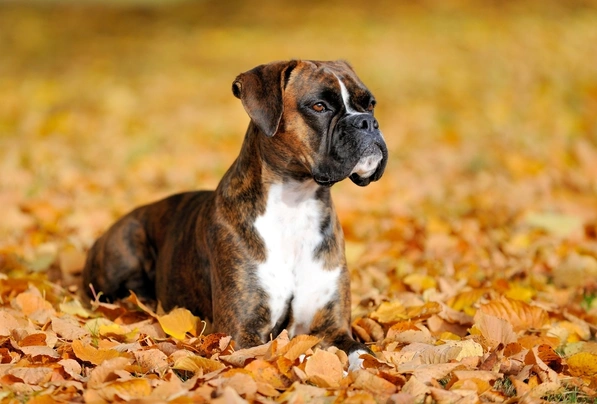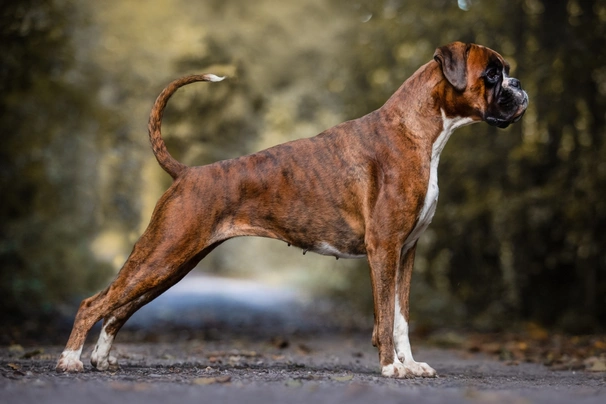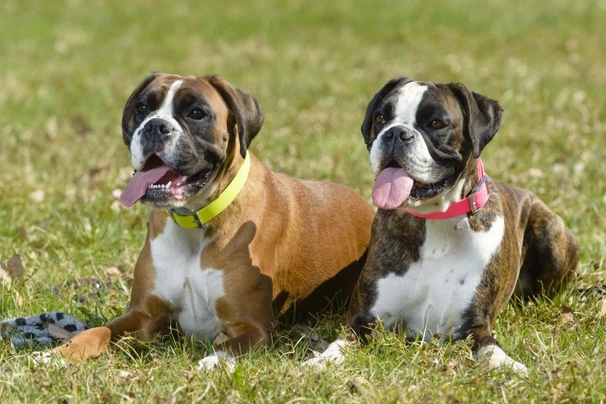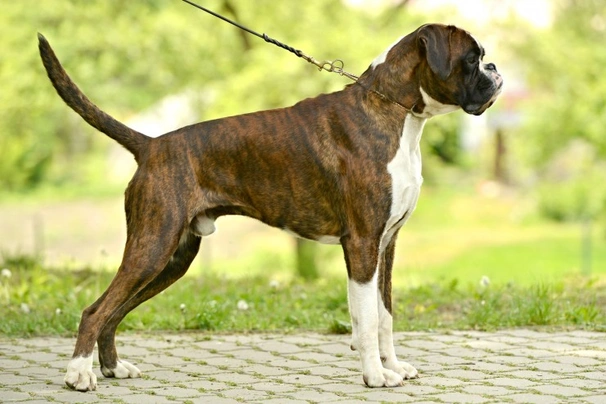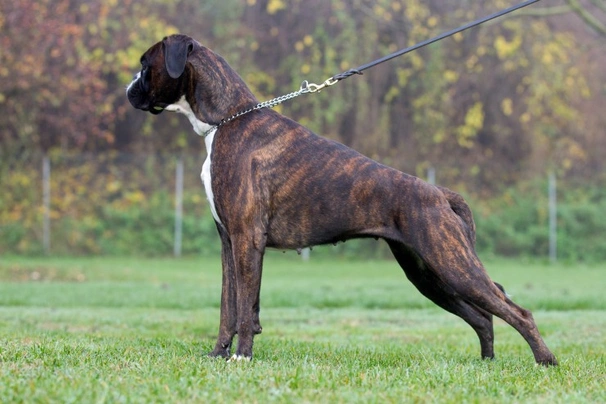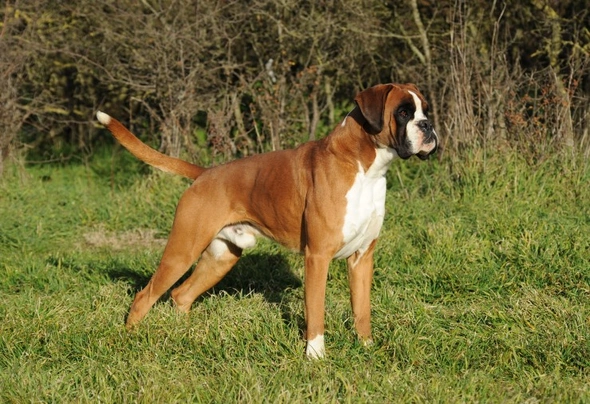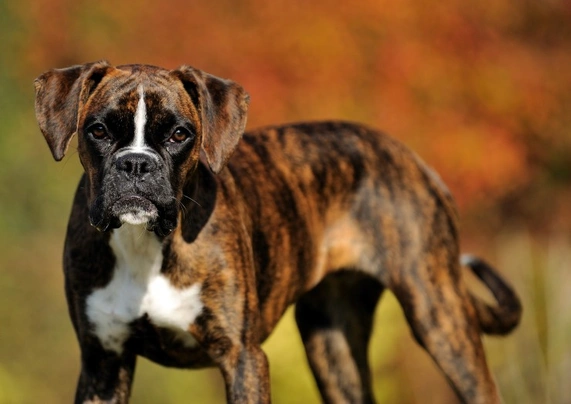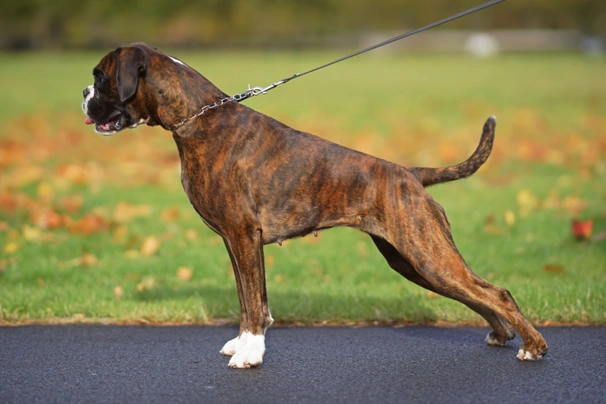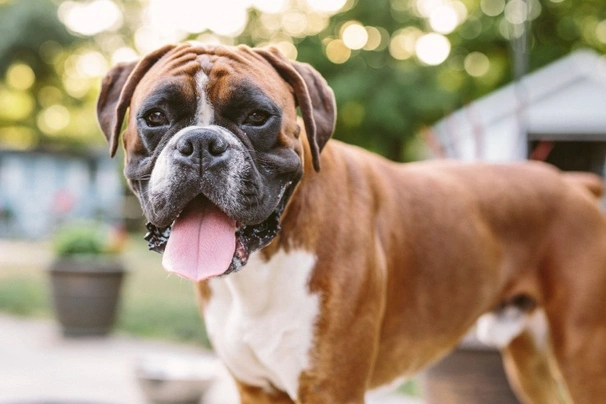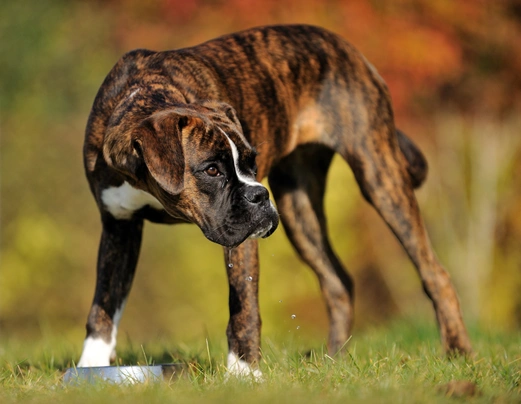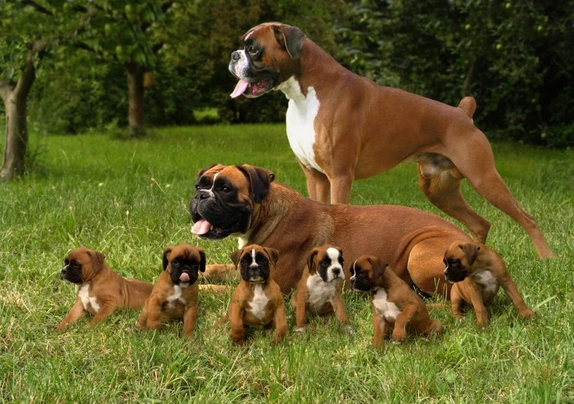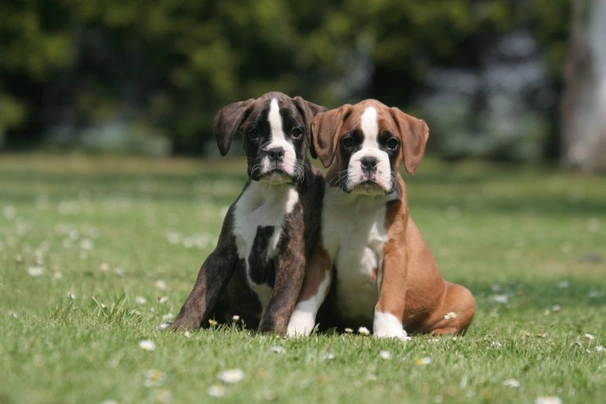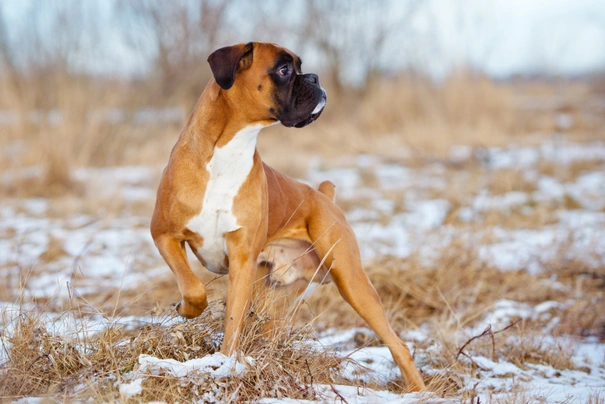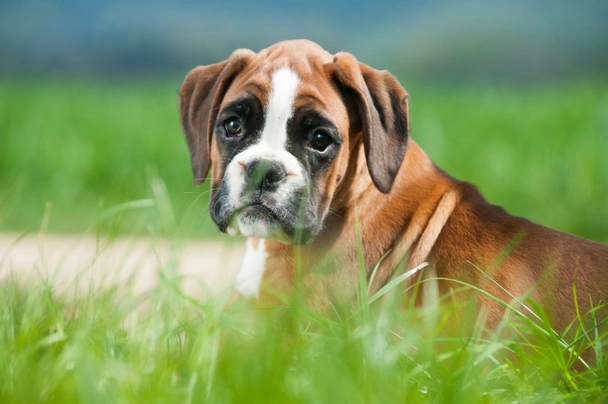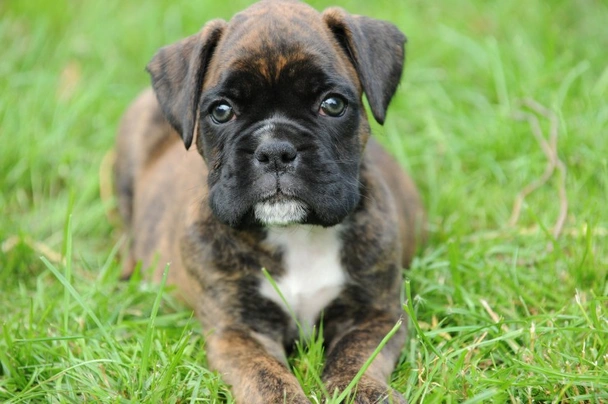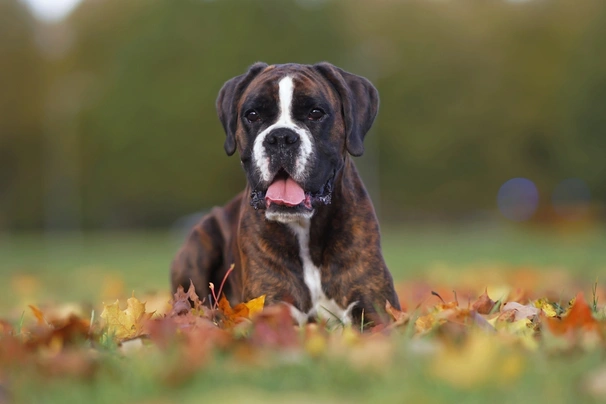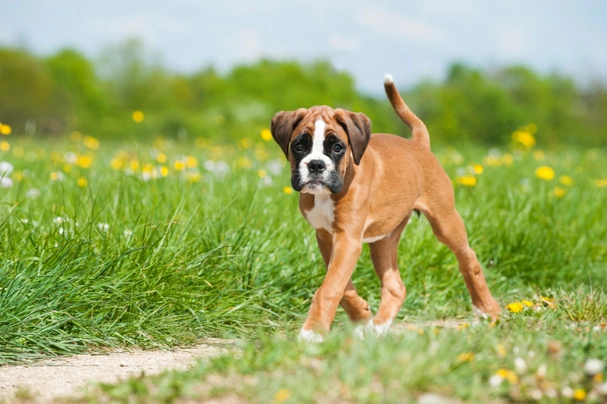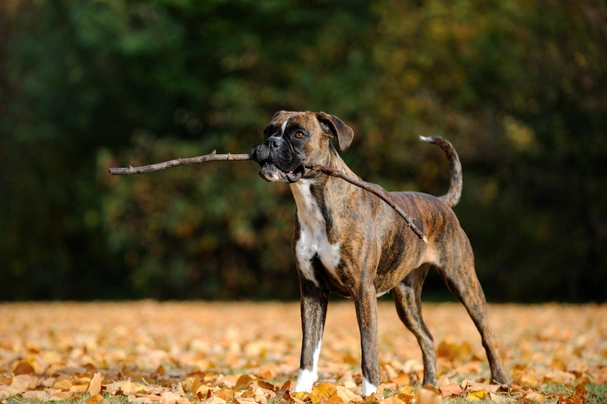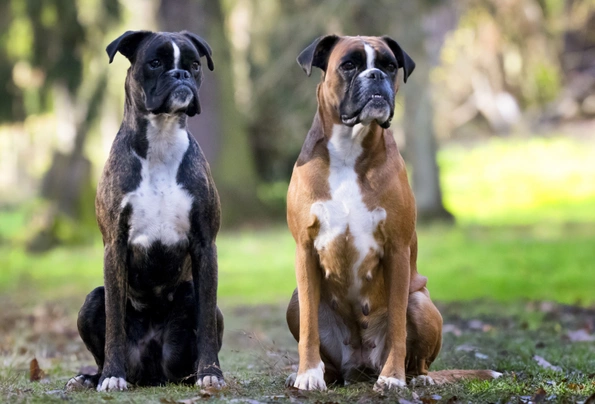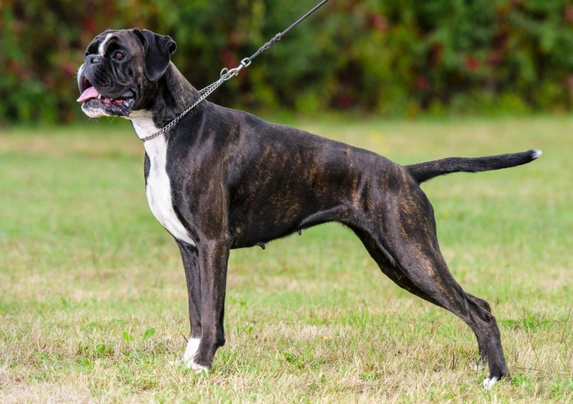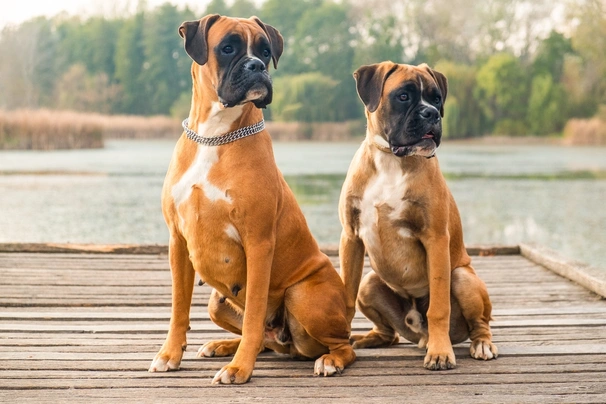Boxer
Pros
Cons
Introduction of the Boxer
Boxers are high energy dogs and are often described as being exuberant extrovert while at the same time being the clowns of the dog world. They love being entertained and to entertain with their silly dances and fun-loving outlook to life. If there is one thing a Boxer is not it's a couch potato. These dogs are extremely loyal and the fact they are so outgoing by nature it means they are great fun to have around. It is said that once a person has owned a Boxer they would never dream of sharing their home with another breed of dog.
The breed originates from Germany where they were bred as working dogs and it's believed that Boxers boasts having several well-known and loved breeds in their ancestry. This includes the Bulldog and Great Dane. Their name comes from a German word "beisser" which was corrupted to Bullenbeisser which translated to English means "bull biter". Boxers are exceptional watchdogs even in a home environment and are very quick to let their owners know if there are any strangers or people about.
The Boxer has consistently been a popular choice of family pet for many years not only here in the UK but elsewhere in the world and for good reason. They are loyal fun-loving extremely good with children of all ages and they are always ready to join in a game with as much gusto as you would hope for from a reliable loving and comical family pet. In short the Boxer is a true and much-loved all-rounder.
History of the Boxer
The Boxer is a relative newcomer to the dog world having been first bred in Germany in the late 1890's. The very first German Boxer was exhibited at a dog show in Munich five years later in 1895 and was called a male called Flocki. He was bred using an English Bulldog called Tom and his mother was Brindle German dog who boasted having an interesting lineage with the Bullenbeissen being in her ancestry. The Bullenbeisser was a fighting dog that was used for blood sports which included bull baiting back in the day before it was outlawed.
It was only in the thirties that Boxers arrived on English shores and a few years later enthusiasts of the breed got together in London to establish "The British Boxer Dog Club". It was not long before the club's membership doubled with six fans of the breed becoming twelve.
That same year in 1936 The Boxer Club was accepted as being an affliate of The Kennel Club and Cruft's Dog Show started including Boxer Classes in their events. A breed standard was established and in 1939 and Boxers were granted Championship status. The first Champion Boxer in the UK was called Champion Horsa of Leith Hill and was awarded the title in 1939. A year later in 1940 the number of Boxers registered with the Kennel Club rose to 33 dogs.
World War II put a stop to things for the next few years but with the help of Mrs. Caro who owned the very first Champion Boxer to be bred in the UK the club survived and prospered gaining new members and before long a revival of the breed took place.
Today the Boxer is known the world over as being among one of the kindest and most fun-loving albeit highly energetic dogs to own. The added bonus being they are extremely kind when around children and other pets rarely showing an aggressive side to their personalities.
Interesting facts about the breed
- Is the Boxer a vulnerable breed? No they are among the most popular dogs in the UK and elsewhere in the world thanks to their devoted and loyal natures
- Boxers are a relatively new breed having been first bred in Germany in the late 1800's
- They are descendants of the Bullenbeisser a German breed of fighting and bull baiting dog
- Boxers were also used to hunt wild boar in days long past
- There is no such thing as a “black” boxer but rather a reverse brindle
- Boxers often like to stand on their back legs and punch at the air with their front ones much like a boxer
- White Boxers are not prone to suffering from more health issues they are however like other white dogs more predisposed to having hearing issues with some being totally deaf and they are more likely to have eye issues too
Appearance of the Boxer
Height at the withers: Males 57 - 63 cm Females 53 - 59 cm
Average Weight: Males 30 - 32 kg Females 25 - 27 kg
One of the most noticeable and endearing physical traits of Boxers is their undershot jaw and unlike in many other breeds this is one trait that is highly desirable in the breed. Their jaw structure means a Boxer has a very strong grip when they take anything in their mouths. They are extremely proud looking dogs that always hold themselves well. They are extremely well-muscled and nicely proportioned from the heads right down to the tips of their tails.
A Boxer's head is another of their defining physical features which should always be well in proportion to the rest of a dog's body and should never show any sort of exaggeration with their occiput never being too pronounced. Boxers have a well-defined stop and the bridge of their noses should never be too far back in a dog's forehead and it should not be downfaced either.
The tip of a Boxer's nose is set a little higher than the root of their muzzles which adds to their unique look. Cheeks are well developed and powerful without any hint of a bulge. The only time a Boxer has any wrinkles on their faces is when they are excited. Their muzzles are always that much darker as compared to the rest of their faces and bodies.
Their eyes are always alert dark brown in colour and have an "intelligent" look about them which is enhanced by the dark rims around them. Their ears are set wide apart on the top part of their head falling to the front when a dog is excited but otherwise they lie flat close to a dog's cheeks. As previously mentioned one of the defining features of the breed is their undershot jaw and their extremely powerful bite.
Their neck is supple and strong being well-muscled with a distinct arch in it that goes right down to a dog's withers. Their forequarters are powerful and square in appearance when seen in profile. Boxers have very deep chests with well arched and well-defined ribcages. Their backs are short and slope downwards to their hindquarters giving these dogs a very powerful appearance even when they are at rest. Their feet are small and very cat-like in appearance with arched toes and their back feet are slight longer than their front ones. A Boxer's tail is set high and dogs tend to carry them high.
When it comes to a Boxer's coat this is short and tight to their bodies being smooth to the touch and glossy looking. These lovely dogs boast a variety of colours which includes the following:
- Black Brindle
- Black Brindle & White
- Brindle
- Brindle & White
- Brindle Black Mask
- Dark Brindle
- Dark Brindle & White
- Fawn
- Fawn & White
- Golden Brindle & White
- Light Brindle
- Light Brindle & White
- Red
- Red & White
- Red & White Black Mask
- Red Black Mask
- Red Brindle
- Red Brindle & White
- Tiger Brindle
- Tiger Brindle & White
- White
Gait/movement
When a Boxer moves they do so powerfully covering a great deal of ground with lots of strength coming from their hindquarters. When seen from the side a Boxer has a free-moving stride and a noble appearance about them.
Faults
The Kennel Club frowns on any exaggerations or departures from the breed standard and would judge all faults on how much they affect a Boxer's overall health and wellbeing as well as their ability to perform as they should.
Male Boxers must have both testicles fully descended into their scrotums and it is worth noting that a Boxer can be a little taller or shorter and they can be slightly lighter or heavier than set out in their Kennel Club breed standard which is given only as a guide to a dog’s appearance.
Temperament of the Boxer
Known to be real clowns Boxers are often referred to as the "jokers of the dog world". They are energetic playful and fun characters to have around and they take a long time to mature. Boxers are always eager to please and extremely loyal dogs by nature. However they need to be handled gently but firmly so they understand their place in the "pack" or they can become a handful and a bit wilful and stubborn when the mood takes them. Boxers must know who is alpha dog and who they can look to for direction and guidance otherwise they will take on the role and show a more dominant side to their natures which is something to be avoided at all costs.
Boxers also need to be well socialised and introduced to new people animals and different situations as early as possible to curb any unwanted behaviours like jumping up when they greet someone which if not nipped in the bud can develop into a real problem. They rarely show any aggressive behaviour but due to their size jumping up can be a little intimidating to people and a dog could accidentally knock a child over by doing so.
Some Boxers can be a little wary when around people they don't know and they are quick to let an owner know when there are strangers about. They need to be kept busy because if a Boxer gets bored through lack of exercise or because they are not given enough mental stimulation they can become quite destructive around the house which includes chewing on furniture and digging up carpets.
Being such hyperactive characters Boxers are a great choice for families and people who love to spend as much of their free time with a canine companion in the great outdoors. They adore playing interactive games which includes things like Frisbee. In general the Boxer is a quick learner because they are intelligent although at times they are known to be a little head strong but with the correct training and handling Boxers are a real pleasure to be around.
Boxers are independent thinkers by nature and will always "test" the limits and commands they are given which is why they must be handled with a firm and fair hand right from the word go and throughout their lives and even then a Boxer would always "try it on" when the mood takes them.
More about White Boxers
There has been a lot of myths about White Boxers and the fact they are rare which is not true at all. In fact 25% of Boxers when first born are white. They are not "albino" either they simply have less pigment in their skin and although some completely white dogs might be thought of as being albino they would have to have "pink" eyes to truly be so. A simply white dog would have normal coloured eyes.
The other difference between an albino dog and a White Boxer is that they are the result of two White Boxers that have the "recessive gene" being mated whereas a white dog that's albino would be the result of having the "albino gene mutation".
Another myth is that White Boxers are more prone to developing and suffering from more health issues but there is no evidence of this being true. With this said because they have lower levels of melamine they are more prone to being sunburnt and of developing skin cancer. Another issue with a lot of white coated dogs including the Boxer is that they are more predisposed to impaired hearing and vision.
Are they a good choice for first time owners?
Boxers are not a good choice for first time dog owners because they are very independent thinkers which can make training them more of a challenge. They are extremely high energy and intelligent dogs as such owners must have the time needed to socialise and train their canine companion correctly from a young age. Owners also need to understand the specific needs of a powerful dominant and high prey drive dog so they never get the best of them.
What about prey drive?
Boxers are fun-loving dogs and they have "fighting dog" in their lineage as such they have a high prey drive and can be quite aggressive if not well socialised and trained correctly from a young enough age. Boxers are "bouncy" dogs and love chasing anything that moves in a joyful but often deadly way which often gets them into trouble especially if they are being walked in the countryside off their leads. Young Boxers must be taught the "no" and the "leave it" command from a young age to prevent them from taking off after other animals which includes other dogs when the mood takes them**.**
What about playfulness?
The Boxer is renowned for being the "clowns of the dog world" and thrive on being around their families and owners loving nothing more than to entertain with their silly antics and dances. They remain very playful throughout their lives which is another reason they are such fun to have around in a home environment.
What about adaptability?
Boxers need to have enough space to express themselves and therefore they are not suited to apartment living. They do a whole lot better when they have a large back garden to romp around in as often as they can making sure the fencing is secure enough to keep an athletic Boxer safely in.
What about excessive barking?
Boxers are not known to be "barkers" although they are natural guard dogs and therefore they are quick to let an owner know when things they don't like are happening in their environment. With this said any dog that’s left on their own for long periods of time would start barking incessantly to let people know how unhappy they are about the situation.
Do Boxers like water?
Some Boxers love being in water although they are not built to be "water dogs" and as such care should always be taken when a Boxer jumps in to take a swim. Because of their build and their shorter noses Boxers find it harder to stay afloat which is part of the reason why care should always be taken when these dogs are around swimming pools or ponds.
Other Boxers don't even like getting their feet wet and it would be a mistake to make them go in water because it would just end up scaring them even more. Care should be taken when walking a Boxer that does like swimming anywhere near more dangerous water courses just in case they decide to leap in.
Are Boxers good watchdogs?
Boxers are exceptionally good natural watchdogs a trait that's deeply embedded in their psyche which in short means they don't need to be trained to guard over and protect anything which could end up making a Boxer a little too over-protective and could even lead to a dog turning aggressive.
Intelligence / Trainability of the Boxer
Boxers are intelligent dogs but they need to be well handled and given the right sort of guidance from a young age for them to be truly obedient dogs. They also need to be well socialised as soon as possible so they get to meet new people other animals and new situations for them to grow up to be calmer more rounded dogs.
Boxers can be boisterous when young which means it can prove difficult to get a dog to focus when they are being taught anything new. With this in mind it's essential for these dogs to be handled firmly right from the word go so they understand their place in the "pack" and who is alpha dog. Boxers can become unruly and wilful if they are not given the right sort of direction and they are extremely quick at picking up any bad habits which need to be nipped in the bud gently but firmly.
It would be a mistake to keep "bribing" a Boxer to get them to do something because it generally means they have succeeded in "training" their owners rather than the other way around. Boxers are highly intelligent even though they play the fool and as such they are extremely fast learners with the downside being they are just as quick to pick up some bad habits as well as the good.
Boxer puppies must be taught limits and boundaries right from the word go bearing in mind that they will also test any ground rules just for the fun of it. Puppies must be taught the basic commands as soon as they arrive in their new homes and this includes the following bearing in mind that it is in a Boxer’s nature to “test” the limits of how far they can go just for the fun of it:
- Come
- Sit
- Stay
- Quiet
- Leave it
- Down
- Bed
Children and other
Boxers are generally very kind dogs when they are around children of all ages and when given the correct guidance they are extremely loyal and protective of their family pack which is something that must be taken into account when the kids have friends over to play. As with any other breed they need to be well socialised and introduced to as many new situations pets and people from a young age to be truly well-balanced and well-behaved dogs and even then their playfulness usually gets the better of them.
They are also known to be good around other dogs and family pets and as previously mentioned a Boxer rarely shows any sort of aggressive behaviour towards other animals providing they have been well enough socialised from a young age. However it's always best to make sure that any introductions to new dogs or other animals goes smoothly by keeping a close eye on things especially when smaller animals and pets are involved thanks to the Boxer's higher prey drive.
Health of the Boxer
The average life expectancy of a Boxer is between 10 - 12 years when properly cared for and fed an appropriate good quality diet to suit their ages.
As with many other pedigree dogs the Boxer is known to suffer from specific health issues more than other breeds which are worth knowing about if you are thinking about sharing your home with one of these fun-loving dogs. The health disorders the breed is known to suffer from includes the following:
- Aortic Stenosis/Sub-Aortic Stenosis (AS/SAS) - Breed Club - Heart testing available and only murmur-free dogs should be used for breeding purposes
- Bloat/Gastric Torsion
- Boxer Cardiomyopathy (ARVC)
- Colitis
- Degenerative Myelopathy (DM)
- Epilepsy
- Cataracts
- Hip Dysplasia - Tests available
- Hypothyroidism
- Cancer
- Cutaneous Asthenia
- Hives and allergies
- Corneal Ulcers
- Skeletal Scurvy Osteodystrophy
- Brachycephalic Obstructive Airway Syndrome
Boxers have also been seen to react badly to a sedative commonly used by vets called acepromazine. As such vets avoid using the sedative when treating a Boxer. The other thing to bear in mind is that because Boxers have flatter muzzles and are a brachycephalic breed care must be taken when exercising these dogs in hotter weather to prevent them from overheating.
More about Aortic Stenosis
Aortic stenosis is a condition that affects a Boxer's heart. The aorta becomes narrower. As a result their hearts have to work much harder to pump oxygenated blood through it and around the body which over time puts it under a tremendous amount of pressure. Another consequence of the condition is when the left heart muscle becoming thicker which is a disorder known as hypertrophy. If the level of blood that flows through a dog's heart falls too low it can lead to dogs fainting and could even result in their sudden death in very severe cases. The noise of the blood as it travels through the narrower opening in a dog's heart can be heard using a stethoscope and is referred to as a heart "murmur".
Back in the eighties the number of Boxers that suddenly died were found to have developed the condition but through careful and selective breeding only using dogs tested clear of the disorder the number has dropped considerably. As such only murmur-free Boxers that have been tested and graded as 0.6 should ever be used in a breeding programme.
More about Boxer Cardiomyopathy (ARVC)
Arrhythmogenic Right Ventricular Cardiomyopathy or ARVC is a disorder seen in Boxers and it affects them more than other heart conditions seen in the breed. It is not the same as cardiomyopathies which can affect other breeds and the reason is due to fatty and fibrous tissues found in a Boxer's heart muscle which results in an electrical disturbance. In cardiomyopathies in other breeds the problem is caused by a thickening of a dog's heart muscle. With this said when a Boxer develops the condition their heart walls can thicken because of the electrical disruption.
A Boxer can suffer from the condition at any point in their lives and there are 3 categories of ARVC which are as follows:
- Concealed - a dog might experience arrhythmias but otherwise there are no other symptoms
- Episodic fainting (syncope) which is generally associated with a dog being excited or having been exercised
- Congestive heart failure
- Sudden death
For the moment Boxers cannot be screened for ARVC but a lot of research is being carried out to establish if and why some dogs develop the condition whereas others do not. The prognosis tends to be variable with many dogs living out their lives and enjoying a good quality of life. However if a Boxer's condition is severe they typically succumb to the disorder even when they are being carefully monitored and treated.
More about hives and allergies
Some Boxers develop hives which is triggered by an allergic reaction to something. Occasionally finding the root cause of the problem is simple more especially if a dog has been stung by an insect. However finding the triggers can often prove challenging and often even with in-depth investigation the cause is never known. A Boxer with the condition develops lumps on their body which can be varying in size from 1 to 2 cm in diameter. Often dogs look like they have been "bubble-wrapped" when they develop hives which is accompanied by quite a bit of discomfort and itching.
It's very important to keep an eye on a Boxer when they do develop hives because it could lead to them suffering from anaphylaxis which can prove life-threatening due to the fact a dog's airways swell up and therefore prevents them from breathing and they would need to see a vet as a matter of urgency so they can be given an antihistamine.
More about corneal ulcers
Thanks to the way a Boxers eyes are constructed they are more at risk of scratching the surface which can lead to corneal ulcers forming. Unfortunately a Boxer's cornea does not heal as quickly as in other breeds and as such a trip to the vet would be well advised so they can examine the affected eye and treat it accordingly sooner rather than later to prevent things from getting any worse and to make a Boxer more comfortable as quickly as possible.
More about Skeletal Scurvy Osteodystrophy
Skeletal scurvy osteodystrophy affects puppies between the ages of 2 and 8 months when they are developing and growing rapidly. The disorder is extremely painful because it affects a puppy's growth plates which are found at the tip of bones in a dog's limbs. It is thought the condition is caused by a Vitamin C deficiency although there is a belief that the disorder is more complex than simply this. With this said a puppy's diet must be well balanced and correctly thought out so it is well balanced and offers all the correct levels of nutrients they need to grow and develop properly.
More about tail docking
Traditionally a Boxer's tail was always docked but since the law banning the procedure came into effect in 2007 tail docking Boxers is now illegal with the only exception being because a dog suffers from some sort of health issue that requires their tails to be docked and the procedure has been agreed and authorised before being performed by a qualified vet.
What about vaccinations?
Boxer puppies would have had their first vaccinations before being sold but it's essential for them to have their follow-up jabs at the right time with the vaccination schedule being as follows:
- 10 -12 weeks old bearing in mind that a puppy would not have full protection straight away but would be fully protected 2 weeks after they have had their second vaccination
There has been a lot of discussion about the need for dogs to have boosters. As such it's best to talk to a vet before making a final decision on whether a Boxer should continue to have annual vaccinations which are known as boosters.
What about spaying and neutering?
A male Boxers can be neutered when they are 6 months old and females can be spayed when they are 6 months old too.
What about obesity problems?
Some Boxers gain weight after they have been neutered or spayed and it's importan to keep a close eye on their calorie intake and the amount of daily exercise they get to prevent obesity. An obese Boxers would be put at risk of developing certain health issues which could end up shortening their lives by several years.
What about allergies?
As previously mentioned Boxer are prone to developing hives which if left untreated can prove notoriously hard to clear up. Sometimes the reason why a dog has a flare up is quite evident but a lot of the time finding the trigger can prove challenging. The main goal is to make a Boxer comfortable as quickly as possible and to then investigate what might be the triggers. The most common causes of allergies and hives in Boxers are as follows:
- Environment
- A reaction to certain chemicals commonly found in household cleaning products
- Seasonal allergies which includes pollen and grasses
- Food which includes certain meats and cereals often used as ingredients in commercially produced dog food
- Tick and flea bites
- Dust mites
- Mould
Participating in health schemes
The Kennel Club strongly recommends that all breeders use the following schemes on all breeding dogs:
What about breed specific breeding restrictions?
As of October 2008 Boxer puppies born with naturally bobbed tails are recorded on their registration certificates with the end goal being to identify lines that carry the tailless gene. Dogs with naturally bobbed tails are often referred to as "bobtail". A veterinary certificate must be provided proving that a puppy was born with a naturally bobbed-tail before being sent to the Kennel Club's litter registration department.
What about Assured Breeder requirements?
The Kennel Club strongly recommends that all Assured Breeders have their stud dogs tested using the following schemes and that other breeders follow suit:
Caring for the Boxer
As with any other breed Boxers need to be groomed on a regular basis to make sure their coats and skin are kept in tip-top condition. They also need to be given regular daily exercise so they remain fit and healthy. Being high energy dogs they are not the best choice for people who lead more sedentary lives because Boxers are extremely demanding when it comes to keeping them well exercised and mentally occupied. On top of this Boxers need to be fed a good quality diet throughout their lives to meet all their nutritional needs.
Caring for a Boxer puppy
Boxer puppies are extremely exuberant in everything that they do and they remain playful throughout their lives. They can also be quite destructive around the home which is why it's a very good idea to limit the number of rooms a puppy can roam in by fitting child gates to specific doors. It is also essential for a house and garden to be thoroughly "puppy-proofed" well in advance of a Boxer puppy arriving in their new home which means putting valuable ornaments somewhere safe and to make sure all electric wires and cables are well out of the reach of a Boxer puppy's jaws.
It's also important to set up a quiet area for a puppy so they can retreat to it when they want to nap bearing in mind that all puppies can sleep up to 21 hours a day which they need to do so they develop and grow properly. The area should not be too out of the way because it's important to keep an ear and eye on a Boxer puppy and for them to know they are not on their own. With this said children need to be taught not to disturb a puppy when they are asleep and to leave them alone when they are eating too.
A Boxer puppy would have been wormed before being sold and the documentation a breeder provides for a puppy must have all the details of their worming date and the product used as well as the information relating to their microchip. It is essential for puppies to be wormed again keeping to a schedule which is as follows:
- Puppies should be wormed at 6 months old
- They need to be wormed again when they are 8 months old
- Puppies should be wormed when they are 10 months old
- They need to be wormed when they are 12 months old
As previously mentioned Boxer puppies are incredibly bouncy and quite comical but it's important not to let them run up and down stairs or to jump up and down on the furniture because their joints and bones are still developing and this would put unnecessary stress on them which could lead to more health issues later in a dog's life.
Things you'll need for your puppy
There are items needed to care for a puppy which should be purchased well in advance of their arrival. The items needed include the following:
- Feed and water bowls making sure they are not too deep and ideally they should be ceramic rather than plastic or metal
- A good quality dog collar harness and lead
- A dog crate that's not too small or too big that a puppy would feel lost in it
- Child gates to fit on doors to keep a puppy safe
- A well-made dog bed bearing in mind that a puppy could well chew on it
- Baby and/or dog blankets to use in the puppy's crate and dog bed
- Dog specific toothpaste and tooth brush
- Shampoo and conditioner specifically formulated for use on dogs
- Grooming equipment
Keeping the noise down
All puppies are very sensitive to loud noises so it is important to keep the volume of a television down and not to play music too loudly either because it could frighten a Boxer puppy and prevent them from napping as they should during the day.
Keeping vet appointments
Reputable breeders would always ensure their puppies vaccinated before they are sold but as previously mentioned it is up to their new owners to make sure they are given their follow-up shots at the right time which should be as follows:
- 10 -12 weeks old bearing in mind that a puppy would not have full protection straight away but would only be fully protected 2 weeks after they have had their second vaccination
When it comes to boosters it's best to discuss these with a vet because there is a lot of debate about whether a dog really needs them after a certain time. However if a dog ever needed to go into kennels their vaccinations would need to be
What about Boxer when they reach their golden years?
When Boxer reach their golden years they do slow down in many ways and they might start showing their age with more grey hairs appearing on their faces and more especially around their muzzles. Apart from a change in their appearance a Boxer personality might change too and this includes on how quick they are to respond to a command or when their names are called. The reason for this is that many older dog's hearing is not as good as it once was. Other changes to watch out for in a Boxer when they reach their senior years include the following:
- Their vision might be impaired and their eyes seem cloudy
- Their teeth might not be as in good condition which means they may need dental work
- Older dogs tend to sleep more during the day and they get up more frequently at night which is often because their cognitive function is not as sharp as it was when they were young which means older dogs are more easily confused
- They tend to be less tolerant of loud noises and sounds
- Dogs when they are older can be a little fussier about their food so it's important to rethink their diet and to make sure they are getting all the nutrients they need to stay healthy
- An older dog's immune system often does not offer them the same protection against illness and infection which puts them more at risk of catching something and why they should see the vet more routinely
- An older Boxer might not be so keen to go out for a walk and more especially longer ones
- They muscle tone and body condition is not as good as when they were young
- Older dogs often suffer from joint problems which can then lead to arthritis so it's well worth investing in a comfy dog bed and ideally one that a Boxer finds easier to get out of
Grooming of the Boxer
Having short tight coats Boxers are relatively low maintenance in the grooming department. However to keep on top of any shed hair and to make sure a dog's coat is kept in good condition they need to be brushed at least once a week. It's also worth bearing in mind that like all other breeds Boxers tend to shed more hair during the Spring and then again in the Autumn when more frequent grooming may be necessary.
It's also a good idea to check a Boxer's ears on a weekly basis to make sure there is no build up of wax which could harbour a yeast infection. A lot of Boxers have quite a bit of white in their coats which means extra care needs to be taken during the hotter summer months to reduce the risk of a dog suffering from sunburn which is all too commonly a problem with Boxers that boast more white in their coats.
It's also a very good idea to keep an eye on the condition of a Boxer's teeth and to teach a puppy that having them regularly cleaned in a good experience right from the word go.
Grooming tools needed for a Boxer
Having the right grooming tools helps keep a Boxer's coat and skin in top condition. The tools needed to keep a dog's coat looking good are as follows:
- A grooming glove
- A slicker brush
- A bristle brush
- A fine toothed comb
- Nail clippers
- A pair of round ended scissors
- Dog specific shampoo and conditioner
Exercise of the Boxer
Boxers need lots of daily exercise and ideally this should be at least 2 hours a day. A good brisk hour's walk in the morning and then again in the afternoon which should include lots of interactive games that would keep a Boxer mentally stimulated.
They are better suited to homes with back gardens where a dog can safely roam around as much as possible so they can really let off steam and express themselves as they should. Boxers are extremely high energy dogs and need to expend all of their pent up energy to be truly happy well-rounded dogs.
Feeding of the Boxer
Boxers need to be fed a good quality balanced diet to suit the different stages of their lives. It's worth noting that they have quite sensitive stomachs which in short means that feeding a Boxer food that has a lot of wheat and other fillers in it would not suit them and could end up causing them quite serious digestive upsets.
If you get a Boxer puppy from a breeder they would have provided a feeding schedule and it is very important that you keep to it. You would also need to feed a new puppy the same type of food as they are used to eating to avoid any tummy upsets. However you can gradually change their food over a period of a few weeks keeping a close eye on things when you do. If you notice any loose stools it's best to put them back on their original diet and to discuss things with the vet before attempting to change their food again.
As previously mentioned Boxers are known to have quite sensitive digestive systems as such it's important they be fed a good quality diet that does not contain wheat or other fillers. If a Boxer proves to be intolerant of the food they are fed they are at greater risk of developing colitis.
It's also very important not to feed a Boxer just before they are due to go out for a walk or any strenuous exercise and the same can be said of when they just get back from a brisk walk. The reason being that Boxers are prone to Bloat and feeding them when they are still too hot could trigger gastric torsion.
Feeding guide for a Boxer puppy
Once a puppy is settled into their new homes it is safe to change their diets but as previously touched upon it needs to be done gradually and carefully to avoid any tummy upsets. As a rough guide Boxer puppies can be fed the following amounts every day to ensure they are getting all the nutrients they need to grow and develop properly:
- 2 months old - 256g to 269g depending on a puppy's build
- 3 months old - 316g to 340g depending on a puppy's build
- 4 months old - 343g to 372g depending on a puppy's build
- 6 months old - 391g to 456g depending on a puppy's build
- 7 months old - 405g to 475g depending on a puppy's build
- 8 months old - 391g to 456g depending on a puppy's build
- 10 months old - 357g to 419g depending on a puppy's build
- 12 months old - 322g to 378g depending on a puppy's build
- 14 months old - 320g to 374g depending on a puppy's build
When a Boxer is 15 months old they can be fed adult dog food.
Feeding guide for an adult Boxer
As a rough guide an adult fully grown Boxer can be fed the following amounts every day to ensure they stay fit and healthy:
- Dogs weighing 25 kg can be fed 256g to 390g depending on activity
- Dogs weighing 30 kg can be fed 302g to 461g depending on activity
Boxer price
If you are looking to buy a Boxer you would need to pay anything from £400 to up to £1500 for a well-bred pedigree puppy. The cost of insuring a male 3-year old Boxer in the north of England is £51.58 a month for basic cover but for a lifetime policy you would need to fork out £98.22 a month (quote as of March 2016). It's also worth remembering that insurance companies factor in quite a few things when they calculate a premium and this includes where you live in the UK and a pet's age and their breed.
When it comes to food costs you would need to buy the best quality food whether wet or dry to feed a Boxer throughout their lives. This would set you back between £60-£70 a month. On top of this you would need to factor in veterinary costs if you want to share your home with a Boxer which includes their initial vaccinations the cost of neutering or spaying your dog when the time is right and then their annual health check visits all of which can quickly add up to well over a £1000 a year.
As a rough guide the average cost to keep and care for a Boxer would be in the region of £120 to £160 a month depending on the level of insurance you opt to get for your pet but this does not include the initial cost of buying a well-bred pedigree Boxer puppy.
Buying advice
When visiting and buying any puppy or dog there are many important things to consider and questions to ask of the breeder/seller. You can read our generic puppy/dog advice here which includes making sure you see the puppy with its mother and to verify that the dog has been wormed and microchipped.
The Boxer is an extremely popular breed both in the UK and elsewhere in the world which means that well-bred puppies command a lot of money. As such with the Boxer there is specific advice questions and protocols to follow when buying a puppy which are as follows:
- Beware of online scams and how to avoid them. You may see online and other adverts by scammers showing images of beautiful Boxer puppies for sale at very low prices. However the sellers ask buyers for money up front before agreeing to deliver a puppy to a new home. Potential buyers should never buy a puppy unseen and should never pay a deposit or any other money online to a seller. You should always visit the pet at the sellers home to confirm they are genuine and make a note of their address.
- As previously touched upon the Boxer is among the most popular breeds in the UK. As such there are many amateur breeders/people who breed from a Boxer far too often so they can make a quick profit without caring for the welfare of the puppies their dam or the breed in general. Under Kennel Club rules a dam can only produce 4 litters and she must be between a certain age to do so. Anyone wishing to buy a Boxer puppy should think very carefully about who they purchase their puppy from and should always ask to see the relevant paperwork pertaining to a puppy's lineage their vaccinations and their microchipping
- Traditionally a Boxer's tail was always docked but since the law banning the procedure came into effect in 2007 tail docking Boxers is now illegal with the only exception being because a dog suffers from some sort of health issue that requires their tails to be docked and the procedure has been agreed and authorised before performed by a qualified vet.

Mum! Dad! I’m here:)
£1,100
5 STAR LICENSED BREEDER. 22 YEARS EXPERIENCE
£2,500
